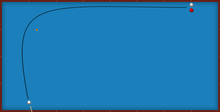Artistic billiards
Artistic billiards, sometimes called fantasy billiards or fantaisie classique, is a carom billiards discipline in which players compete at performing 76 preset shots of varying difficulty. Each set shot has a maximum point value assigned for perfect execution, ranging from a four-point maximum for lowest level difficulty shots, and climbing to an 11-point maximum for shots deemed highest in difficulty level. There are a total of 500 points available to a player, representing the combined value of a perfect score on all 76 shots, although not all games are played with the full shot catalogue. The governing body of the sport is the Confédération International de Billard Artistique (CIBA).
Each shot in an artistic billiards match is played from a well-defined position (in some venues within a two millimetre tolerance), and each shot must unfold in an established manner. Players are allowed three attempts at each shot. In general, the shots making up the game – even four-point shots – require a high degree of skill, devoted practice and specialized knowledge to perform. Such shots often require extremes in shot-making techniques that are not often employed in other games, such as force follows, force draws, precision multiple-rail kicking, jumps and massés combined with outlandish use of english (sidespin).

Players may use up to twenty separate cues providing different performance functions. For example, performing massés may require a cue with a very large diameter terminus and a specialized cue tip, while jumping may require a short, light cue with a flat (rather than rounded), very hard and also wider cue tip than a playing cue. Some shots may require the use of props such as a small pin placed precisely on the table surface and around which the player is required to make the cue ball pass on a designated side (see Figure A10 illustration). For the most part, top artistic billiard players specialize in the game to the exclusion of all others.
World title competition first started in 1986 and required the use of ivory balls. However, this requirement was dropped in 1990. The highest score ever achieved in world competition was 374, by the Frenchman Jean Reverchon in 1992, while the highest score in competition overall is 427 set by the Belgian Walter Bax in 2006.[1] The game is played predominantly in Western Europe, especially in France, Belgium and the Netherlands. The game employs a specialized vocabulary, chiefly derived from French words, encompassing many terms that have no analogues in other cue sports disciplines. Some examples are coup fouetté ("whip shot"; a type of force follow); massé coulé (a massé shot with follow) and piqué (describes either a massé shot with no english, or a shot in which the cue stick is steeply angled, but not held quite as vertical as it is in full massé).
Artistic pool
Artistic pool trick shot competitions on pocket billiards tables, inspired by artistic billiards, began in 1993 in the US at an amateur level and in 2000 professionally and internationally, featuring fifty-six pre-set shots to attempt.[2][3]
References
- "Iwan Simonis ranking Artistiek biljarten, BC Lugo 10 - 11 - 12 maart 2006". VAS - Online (in Dutch). Ravels, Belgium: Vereniging Artistik Spielers. 2007. Archived from the original on March 22, 2007. Retrieved February 26, 2010.
- "2005 / 2006 Shot Program". ArtisticPoolPlayers.com. Artistic Pool and Trick Shot Association. 2005. Archived from the original on 30 June 2007. Retrieved 2007-07-23.
- Rossman, Tom (2003). "'Artistic Pool' History". ArtisticPool.org. Artistic Pool and Trick Shot Association. Archived from the original on 13 July 2007. Retrieved 2007-07-23.
- Shamos, Michael Ian (1993). The Illustrated Encyclopedia of Billiards. New York, NY: Lyons & Burford. pp. 10, 61, 147 and 171. ISBN 1-55821-219-1.
- Martin Škrášek (2000). What's Artistic Billiard?. Retrieved November 30, 2006.
